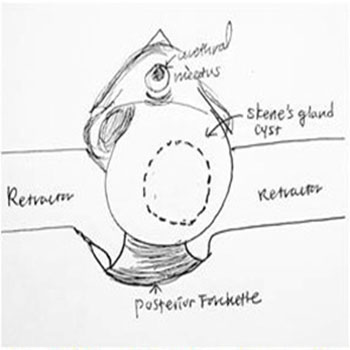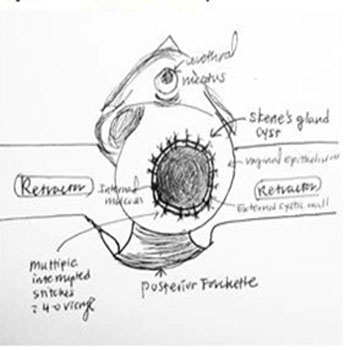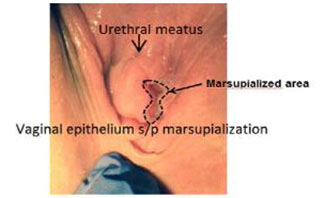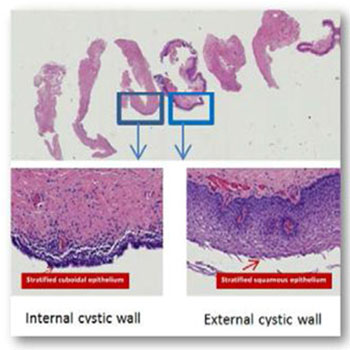Previous Issues Volume 2, Issue 1 - 2017
Marsupialization of Skene’s Gland Cyst
Woojin Chong*, John Andrew Fantl
Division of Female Pelvic Medicine and Reconstructive Surgery, Department of Obstetrics, Gynecology and Reproductive Science at Mount Sinai Medical Center, NY. Corresponding Author: Woojin Chong, Division of Female Pelvic Medicine and Reconstructive Surgery, Department of Obstetrics, Gynecology and Reproductive Science, Mount Sinai Medical Center, New York, Email: [email protected]
Received Date: 01 Jun 2017 Accepted Date: 05 Jun 2017 Published Date: 12 Jun 2017
Copyright © 2017 Chong W
Citation: Chong, W and Fantl, JA. (2017). Marsupialization of Skene's Gland Cyst. Mathews J Gynecol Obstet. 2(1): 010.
ABSTRACT
Background Skene's glands are female homolog of male prostate. The management of Skene's gland cyst is somewhat controversial. Case A 24 year-old woman presented to Urogyn clinic with “bulge in my vagina” for the past 10 years, complaining discomfort of during sexual intercourse, interrupted voiding and deviation of urinary stream. Initial conservative management and observation were not effective. The patient underwent marsupialization of the Skene gland cyst and symptoms resolved completely at 4 weeks postop visit. Conclusion Marsupialization of Skene's gland cyst resulted excellent clinical outcome in a short term.
KEYWORDS
Skene's Gland; Skene's Cyst; Marsupialization.
INTRODUCTION
Skene's glands are female homolog of male prostate [1]. The glands are located laterally on each side of the urethral meatus. The standard treatment protocol for Skene's gland cysts remains undetermined as such cysts are rare. Surgical methods include partial excision, marsupialization and complete excision [1-4].
CASE PRESENTATION
A 24 year-old woman presented to the Female Pelvic Medicine and Reconstructive Surgery clinic with a chief complaint of "a vaginal bulge". In addition, she reported discomfort of during sexual intercourse, interrupted voiding and deviation of urinary stream. On examination, a 3x3 cm, cystic mass was observed to the left of the urethral meatus. No evidence of infection was noted and post void residual was 10cc. Diagnosis was cystic Skene's gland. Initial conservative management and observation were not effective. The patient underwent marsupialization of the Skene gland cyst. This included a circular incision on the vaginal epithelium overlying the cystic gland which included both vaginal epithelium and underlying cystic wall (Figure 1a).
Figure 1a: Skene's Gland Cyst. Using #15 blade and Bovie electrocautery, a circular incision was made on the vaginal epithelium over the Skene's Gland Cyst.
Small mucoid material was drained. The vaginal epithelium and the cystic wall were subsequently incorporated in several interrupted 4-0 Vicryl stitches (Figure 1b).
Figure 1b:Marsupialization of the Skene's Gland Cyst. The cystic wall was identified and transected. Along with vaginal epithelium, the cystic wall is marsupialized using 4-0 Vicryl with multiple interrupted stitches.
At 4 weeks from the procedure, the patient was asymptomatic and reported a straight and continuous urinary stream. Patient had not yet engaged in sexual intercourse. The cystic walls remained collapsed (Figure 2). Histology revealed benign findings (Figure 3).
Figure 2: Postoperative Presentation after 4 Weeks.
Figure 3:H&E Histologic Findings.
DISCUSSION
Skene's glands are bilateral and located at the bottom of the distal urethra [1]. The glands help to lubricate the urethral meatus. Obstruction of the ducts leads to the formation of cyst [1]. The cyst may present as a small, cystic mass, just lateral or inferolateral to the urethral meatus and it can become inflamed or infected. As Skene's ducts are embryologically derived from the urogenital sinus, these cysts are lined by stratified squamous epithelium [1]. Differential diagnoses of paraurethral cysts include urethral diverticulum (most common), vaginal cysts (Skene's gland cyst), fibromuscular tissue, leiomyomata, ectopic ureteroceles, vaginal squamous cell carcinomas or infected granuloma [2]. Skene's gland cysts are differentiated from urethral diverticulum by location of the cyst: lateral location (skene's gland cyst) vs suburethral location (diverticulum) [5]. When conservative managements are not effective, excision and marsupialization are the surgical options for Skene's gland cyst [2-4]. The reason why marsupialization was done for this case, instead of excision, was because the cyst was elongated along the urethra and the excision would have damaged the surrounding tissue if the cystectomy was performed. Marsupialization of Skene's gland cyst can be a good surgical option with excellent clinical outcome.
TEACHING POINT
When conservative managements are not effective, excision and marsupialization are the surgical options for Skene's gland cyst.
REFERENCES
- Eilber KS and Raz S. (2003). Benign cystic lesions of the vagina: a literature review. 2003. J Urol. 170(3): 717-722.
- Foster J, Lemack G and Zimmern P. (2016). Skene's gland cyst excision. Int Urogynecol J. 27(5): 817-820.
- Shah S, Biggs G, Rosenblum N and Nitti V. (2012). Surgical management of Skene's gland abscess/infection: a contemporary series. Int Urogynecol J. 23(2): 159-164.
- Blaivas JG, Flisser AJ, Bleustein CB and Panagopoulos G. (2004). Periurethral masses: etiology and diagnosis in a large series of women. Obstet Gynecol. 103(5 Pt 1): 842- 847.
- Sharifiaghdas F, Daneshpajooh A and Mirzaei M. (2014). Paraurethral Cyst in Adult Women: Experience with 85 Cases. Female Urol J. 11(5): 1896-1899.



